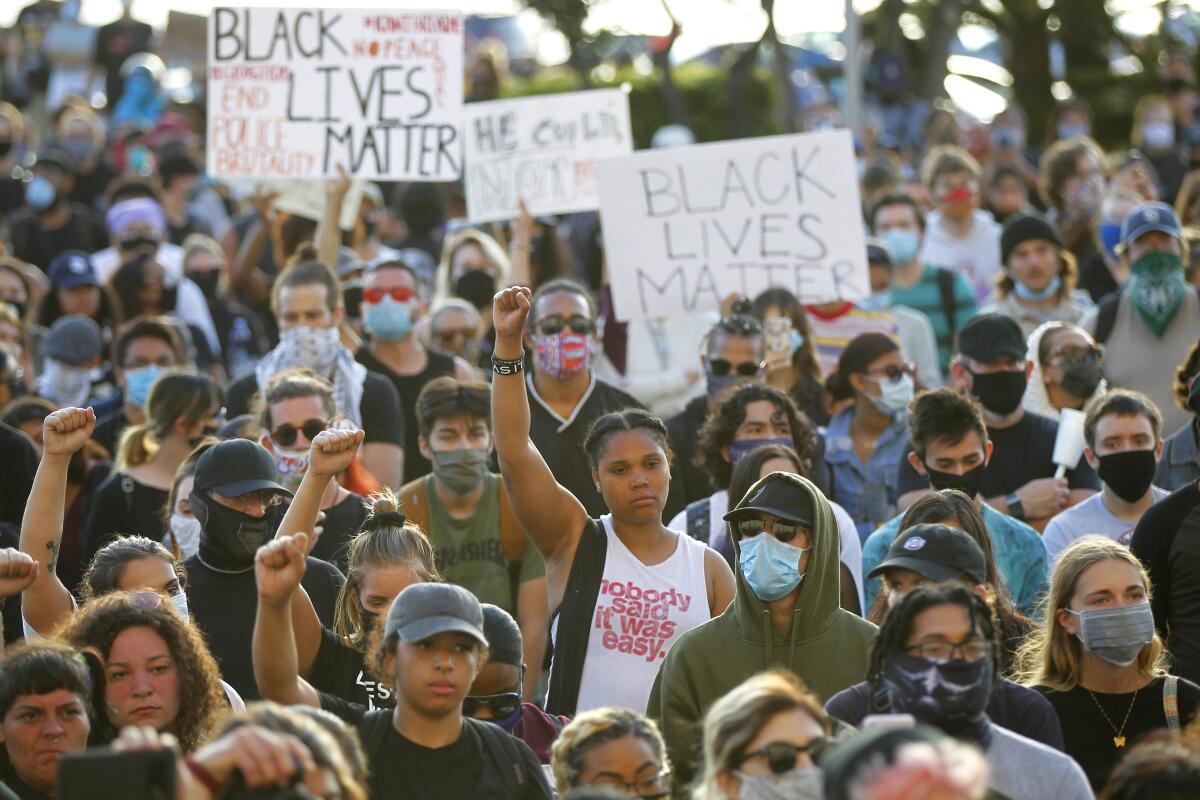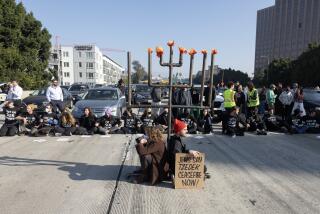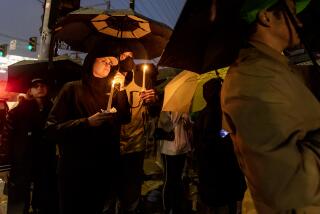As protests continue across San Diego County, a new generation of organizers is emerging

SAN DIEGO — When Ariel Gibbs arrived May 31 at San Diego’s Hall of Justice, the place where her protest was set to begin, she paused and turned to a friend.
“Wow,” she said.
Gibbs could not believe how many people showed up to march alongside her to demand justice for George Floyd, a black man who died after a white police officer in Minnesota knelt on his neck for nearly nine minutes.
By 10 a.m., there were about 100 people present. Throughout the day, the crowd would grow to more than 1,000.
In the past week, San Diego County has seen multiple protests each day as residents join the voices across the nation angered by Floyd’s killing by police — and the deaths of many other black men and women — and calling for change.
From Escondido to downtown San Diego, protesters are kneeling, chanting and marching together. Many have stood side by side in moments of somber silence while wearing masks to protect themselves from the threat of the coronavirus. In other moments, they have shouted the names of other black men and women who have lost their lives to police violence, including 26-year-old Breonna Taylor, who was killed in March by police inside her home in Kentucky.
The series of demonstrations began late last week with a protest in La Mesa that was peaceful for hours. Tensions rose when protesters made their way past lines of officers blocking their way onto a section of the 8 Freeway. Officers and deputies attempted to control the crowd, eventually deploying tear gas and flash-bangs, and firing beanbags and other less-than-lethal rounds. Some people threw water bottles and other items at the officers.
As night fell, some people in the crowds began vandalizing businesses, breaking windows and starting fires.
Since then, local protests have been largely peaceful, with many organizers emphasizing the call for crowds to remain nonviolent.
While some recent demonstrations have been planned by established social justice organizations, several of the most visible events have been arranged by first-time protest groups. Others became leaders during the course of the event, stepping up in moments of need.
A tipping point
Gibbs, a 25-year-old black woman, said she had participated in protests related to police brutality for years, beginning when she lived in Chicago, but this was the first time she’d organized a demonstration.
She said she felt motivated to step up after Floyd was killed.
“I reached that tipping point,” Gibbs said. “Enough was enough. I’m saddened by all black lives that are lost to the hands of police brutality or white supremacy or racism, but this was particularly heart-wrenching to me.”
She didn’t expect the response that she got. But she believes the people who joined her must’ve reached their tipping points, too.
On May 31, Gibbs and a small group of friends led the protest in moments of silence and chants across the city.
After Gibbs left to rest following hours of marching, protesters ended up back in front of the Hall of Justice, where police lines pushed into them. A few protesters threw water bottles at officers, and police responded with flash-bangs and tear gas in an attempt to disperse the crowd. Overnight, there were reports of theft and broken windows.
Gibbs doesn’t want to be associated with the actions of those who chose to destroy property, nor does she but condemn them.
“I don’t want to participate in that, and that’s it, but I’m not going to judge anyone in how they feel or how they choose to express their emotions,” she said. “I don’t want those things to be associated with myself and how I’m choosing to demand my change.”
Gibbs, who has a master’s degree in sociology, is quick to talk about policy changes. She said she wants to see a statewide ban on the carotid restraint, a controversial neck hold that nearly all law enforcement agencies in the region chose to stop using this past week. The countywide move follows Floyd’s death but also years of demands from local activists.
Gibbs also wants an independent commission to review police misconduct reports and community involvement in police training.
Though she’s glad to see city and county departments making changes, she said there is still much work to be done. She’s hoping to plan more events to help educate community members about local government and get them civically involved.
“The system wasn’t built in a day,” Gibbs said. “Therefore, it cannot be torn down in a day.”
‘If I didn’t step up, no one else would’
K.C. Short, 30, had never organized a demonstration before planning a May 30 protest in La Mesa.
He had seen a video — shared widely online — of a La Mesa police officer arresting Amaurie Johnson, a 23-year-old black man. The video from May 28 shows the white officer pushing Johnson down onto a bench several times and then detaining him. Johnson was cited on suspicion of assaulting an officer and resisting arrest. He denies the claims.
Short, who is black, called the arrest ridiculous.
“I never really thought I could be an activist,” the Army veteran said. “I felt very strongly about things I didn’t agree with, but I’ve never taken the initiative to really lead. I was the guy who shared something on Facebook. But I really felt in my heart that if I didn’t step up, no one else would.”
Short said he and his girlfriend spent less than a day getting the word out on various social media sites. They planned to demand justice for Floyd — but they also wanted to see the charges against Johnson dropped.
The couple never expected hundreds of people to show up.
“So many diverse people were down for the cause,” Short said. “They all wanted the same thing — justice for everyone and equality.”
Short said he stood with the crowd for hours and then went home about 6 p.m. That night, the demonstration took a violent turn. Police tried to get protesters to leave by firing tear gas and shooting rubber bullets. Some people damaged nearby buildings and stole from businesses. Two banks were burned.
“We were very, very disappointed that it turned into a negative situation,” Short said. “I couldn’t sleep that night because I felt like I had let the residents of La Mesa down when so many had come out to support me.”
Filling a void
Kisi, 18, who co-organized a May 31 vigil outside the County Administration Center, also stepped into a leadership role because she didn’t see others taking action. She teamed up with another young organizer she met in person only on the day of the event. She asked that her last name not be published because she fears retaliation over her organizing work.
After Floyd’s death, Kisi was angry and was waiting for established social justice organizations to put together a protest. But that wasn’t happening because of the COVID-19 pandemic.
“This isn’t about me, this isn’t about you, this isn’t about some other organization,” Kisi recalled yelling at someone over the phone as she tried to find a protest to join. “This is about the fact that for 400 years black people in America have been facing consistent violence and oppression.”
Kisi, who has a black father and white mother, said that because she grew up in a largely white neighborhood, this week’s protests have made her feel connected to San Diego’s black community for the first time.
“This is something that I am willing to risk my life to be doing,” Kisi said. “I refuse to live in a world where this keeps happening to black people. I refuse to live in a world where violence and oppression against black people is the norm. I’m going to keep speaking up about that until my last breath.”
After a standoff with police, the crowd from the downtown protest marched toward Kisi’s waterfront vigil. She and the co-organizer quickly moved to prepare, passing instructions to those already in attendance so they could act as examples for the incoming crowd.
As the flow of protesters joined the vigil’s ranks, they began an eight-minute moment of silence, marking the minutes Officer Derek Chauvin pinned Floyd’s neck with his knee in Minneapolis.
Kisi couldn’t see the end of the crowd as she looked around.
As the co-organizer passed the megaphone to different speakers from diverse backgrounds, a few in the crowd called out that more black voices should be heard. Kisi said she worried about that critique even before the vigil began, and she hopes organizers will work to amplify black voices going forward.
After speeches, songs and spoken word, the organizers called an official end to the event shortly before the county-imposed curfew. But Kisi stayed and saw police tear-gas protesters again outside the county building.
Later, she saw protest groups in Little Italy stopping people who wanted to vandalize and steal. She’s seen that mentality extend into the peaceful demonstrations last week, many of which have been led by young people like herself, she said.
New perspectives
A day after Kisi’s vigil, two other young organizers held a protest. Alex Perez, 17, and Nikki Sanchez, 18, had participated in protests and had some organizing experience from school, but it was the first time they had planned a demonstration.
“I was tired of waiting for other people to do it for us,” Perez said. “If we have the connections and the resources and the information, I figured why not do this, you know?”
Perez said they might’ve been a little naive about how much work goes into planning a protest.
After publishing their event flier, the teens received questions, Perez said, like what was their safety plan. The feedback helped them prepare for the things they hadn’t thought of.
Sanchez, who is not black, said she learned this week the importance of listening more to black leaders and taking a step back from visible roles herself.
At their protest, one black speaker criticized weekend protesters for calling on police to join the demonstrations. That creates a photo opportunity without bringing about actual change, Sanchez learned.
Sanchez hadn’t considered that perspective.
The teens’ protest met up with another demonstration on Monday put together by Mina Donahue. The 25-year-old San Diegan had participated in several protests, but — like the others — had never planned a demonstration.
She created an event on Facebook and watched as it spread. Soon she was getting messages from people who wanted to help.
“It all happened very organically. It grew by itself,” she said. “People want to get together, and if you provide an opportunity that is rooted in love, I feel like it gives people the safety and security to do so.”
Taking the lead
Protests against police brutality are not new, said historian and UCLA professor Brenda Stevenson. Pushing back on abuse from law enforcement goes back to the American Revolution, she said, and protests focused on mistreatment of black people predate the Civil War.
It was an issue brought up repeatedly during the civil rights movement. Though many leaders from that era are now icons in history books, Stevenson said, at the time, they were often vilified.
She said the COVID-19 pandemic, combined with organizing networks that have grown in response to the Trump administration, may have created a particularly poignant moment for change.
“You would have to go back to 1992 to get to a moment that feels this tense,” Stevenson said, referring to the year that Los Angeles officers were acquitted in the beating of Rodney King. “I think people are responding to that.”
The unrest in 1992 led to some local changes, but the United States still needs to acknowledge the problem of racism before substantive reform can happen, she said.
San Diego’s new organizers pushing for that change are not working alone.
Once a protest gets going, leadership is often fluid. Demonstrations may last longer than initially intended. Some organizers may need to head home. Some may just need a break. In those instances, there is invariably someone in the crowd ready to step up.
Experienced activists and established organizations are also offering support.
Francine Maxwell, president of the NAACP’s San Diego branch, said attorneys who contacted her organization are offering free assistance to demonstrators who may have been arrested while participating in peaceful protests.
Maxwell said several young protest organizers have reached out to her organization to speak with lifelong members. Via Zoom calls, two generations of activists had the chance to share their individual experiences and learn from one another, she said.
“I think the best is yet to come from what they’re doing,” Maxwell said. “And we will always be here, some of us on the sidelines, some of us walking next to them, but I believe if they stick with this, they will see the fruits of their labors.”
Morrissey and Winkley write for the San Diego Union-Tribune.
More to Read
Sign up for Essential California
The most important California stories and recommendations in your inbox every morning.
You may occasionally receive promotional content from the Los Angeles Times.












